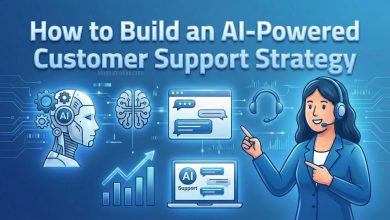How Ecommerce Website Works ? : Comprehensive Guide 2025
How Ecommerce Website Works : E-commerce websites are digital storefronts that enable businesses to sell products or services online. In 2025, online shopping continues to dominate the retail space, and understanding how these websites function is vital for entrepreneurs, developers, and digital marketers alike.
Table of Contents
From displaying products and handling payments to managing orders and delivering packages, an e-commerce website orchestrates a wide range of processes that create a seamless buying experience for customers. With the rise of platforms like Shopify, WooCommerce, Magento, and BigCommerce, building and managing an e-commerce site has become more accessible than ever.
Front-End of an E-commerce Website: User Experience and Design

The front-end is what users see and interact with. Built using technologies like HTML, CSS, JavaScript, and frameworks like React or Vue.js, this layer includes product pages, search bars, navigation menus, shopping carts, and checkout forms.
Also Read : Top 10 Winning Dropshipping Niches for 2025
A good front-end design ensures mobile responsiveness, fast load times, and intuitive navigation—all of which impact user experience (UX) and search engine rankings. Features like product filtering, quick view, image zoom, and customer reviews enhance the customer’s ability to make buying decisions quickly and confidently.
Back-End Development and Server-Side Technologies
The back-end is the backbone of any e-commerce website. It handles the business logic, connects to the database, processes requests, and manages data securely. Built using server-side programming languages like PHP, Python, Java, or Node.js, this layer ensures all information flows seamlessly between the user interface and data storage. It supports admin panel functions like order tracking, inventory updates, product uploads, customer management, and shipping settings. The admin dashboard also plays a crucial role in controlling the daily operations of the store.
Product Catalog and Inventory Management System
Every e-commerce store features a product catalog, which is essentially a database of all available items. Each product entry includes a title, SKU, description, images, category, price, and stock count. Inventory management systems automatically update product availability after each order. Many modern stores integrate real-time inventory tracking and support features like low-stock alerts, supplier syncing, or dropshipping. Accurate inventory management prevents over-selling and ensures customers aren’t disappointed by stockouts.
Shopping Cart Functionality and Checkout Flow
The shopping cart serves as a temporary repository for selected products before a purchase. It stores item details, pricing, tax calculations, and user preferences through cookies or sessions. The checkout process must be simple, secure, and fast to minimize cart abandonment. It usually includes a step-by-step flow: inputting shipping details, selecting a delivery method, choosing a payment option, and confirming the order. Guest checkout and autofill features help speed up this process, while progress bars and trust badges increase user confidence.
Payment Gateways and Online Transactions
One of the most critical components of how an e-commerce website works is payment processing. E-commerce sites integrate with payment gateways like PayPal, Stripe, Razorpay, Paytm, or PayU to securely handle online transactions. These gateways encrypt sensitive data using SSL certificates and facilitate credit/debit cards, net banking, UPI, and wallet payments. They also verify and authorize payments, return transaction tokens, and confirm orders. Security compliance like PCI-DSS ensures safe handling of cardholder data, which is crucial for customer trust and legal protection.
Order Management and Fulfillment Systems
After a payment is successfully processed, the order management system (OMS) takes over. This system records the order, sends confirmation emails to the buyer, updates the inventory, and forwards order details to the warehouse or fulfillment partner.
Also Read : Top 5 Dropshipping Websites 2025
For businesses that rely on third-party logistics (3PL), integration with delivery services like Blue Dart, Delhivery, Shiprocket, or India Post ensures automated label printing, shipment tracking, and delivery notifications. The OMS also handles returns and refunds, which are essential for maintaining customer satisfaction.
E-commerce Security and Data Protection
E-commerce websites handle a large volume of sensitive user data including personal information and payment credentials. Therefore, implementing advanced security measures is non-negotiable. These include SSL certificates, HTTPS protocols, firewalls, malware scanning tools, login protections like two-factor authentication (2FA), and data encryption. Compliance with global and local data protection laws like the GDPR and India’s DPDP Act 2023 is mandatory. Ensuring user trust through transparency in data handling and strong cybersecurity protocols is essential for long-term success.
Search Engine Optimization (SEO) for E-commerce

E-commerce SEO is key to driving organic traffic and increasing visibility on search engines. Optimizing product pages with relevant high-ranking keywords, meta titles, descriptions, image alt texts, and structured data helps Google index the site properly. Clean URLs, mobile responsiveness, fast page loading speeds, and SSL certification also affect rankings. On-page elements like internal linking and user-friendly navigation structure further contribute to SEO success. Tools like Google Search Console and SEO plugins help site owners monitor and improve search performance continuously.
Marketing Integrations and Customer Engagement
Beyond SEO, marketing integrations play a major role in driving traffic and boosting sales. Email marketing platforms like Mailchimp or Klaviyo allow store owners to send promotional emails, abandoned cart reminders, and loyalty offers. Facebook Pixel and Google Ads tags enable targeted ad campaigns based on user behavior. Push notifications, SMS alerts, and WhatsApp marketing help stay connected with customers in real time. Integrating CRM tools ensures better customer relationship management, while affiliate and referral programs can drive additional conversions.
Personalization and AI-Driven Recommendations
Modern e-commerce websites often incorporate artificial intelligence and machine learning to personalize the shopping experience. These systems analyze user behavior—like browsing history, cart activity, and past purchases—to offer smart product recommendations. AI chatbots provide real-time support, while dynamic content engines tailor homepage displays, banners, and offers based on customer segments. Personalization increases engagement, reduces bounce rates, and boosts average order values by making the shopping experience more relevant and user-friendly.
Mobile Commerce (M-Commerce) and Mobile Optimization
With the majority of online shoppers browsing from smartphones, mobile optimization is a must. E-commerce websites must load quickly, display products clearly, and allow easy navigation on smaller screens. Mobile-optimized checkouts, tap-friendly buttons, and biometric payment integrations improve conversions. Progressive Web Apps (PWAs) and mobile apps go a step further by offering push notifications, offline access, and faster performance. AMP (Accelerated Mobile Pages) support helps boost mobile SEO and reduce load time dramatically.
Localization: Multi-Language and Multi-Currency Features
For businesses aiming at international markets, localization is essential. E-commerce websites often support multiple languages, currencies, and region-specific shipping or tax rules. Platforms like Shopify and Magento allow different storefronts for different countries, or dynamically adjust content using IP geolocation. Localized content, culturally relevant marketing campaigns, and locally preferred payment options increase trust and conversions among global customers.
Analytics and Reporting for Data-Driven Decisions
E-commerce analytics tools help track visitor behavior, traffic sources, conversion rates, average order values, and product performance. Google Analytics, Facebook Business Manager, and custom dashboards provide deep insights into what’s working and what isn’t. Sales reports, customer segmentation, and cohort analysis help business owners make informed decisions. KPIs like customer acquisition cost (CAC), customer lifetime value (CLV), and return on ad spend (ROAS) are critical metrics in optimizing profitability.
Future Technologies in E-commerce
The future of e-commerce is being shaped by innovations like AR/VR, voice commerce, and blockchain. Augmented Reality helps customers visualize products—like trying on clothes or placing furniture in their room. Voice search is already becoming a significant part of e-commerce via Alexa or Google Assistant integrations. Blockchain offers transparent supply chains and secure smart contracts. Sustainable e-commerce, eco-friendly packaging, and ethical sourcing are also emerging trends that appeal to conscious consumers.
Scalability and Hosting Infrastructure
As your online store grows, it must be capable of handling increased traffic, data, and transactions without downtime. Scalable cloud hosting solutions like AWS, Google Cloud, or DigitalOcean provide performance optimization, security, and high uptime. Content Delivery Networks (CDNs) help serve site content faster to users worldwide. Auto-scaling resources, caching layers, and performance monitoring tools ensure that even during flash sales or holiday rushes, your website stays functional and fast.
How Ecommerce Website Works Conclusion :

Understanding how an e-commerce website works is crucial for anyone looking to thrive in the online business world in 2025. From front-end design and product management to payment integration and order fulfillment, every piece of the e-commerce puzzle must work in harmony.
Buy Now : Ecommerce Website With 100 Products
As consumer expectations rise and technology continues to evolve, staying informed about the architecture and ecosystem of e-commerce websites can provide a significant competitive edge. Whether you’re a solopreneur building your first store or a growing brand scaling up, mastering these fundamentals is key to building a successful and sustainable online business.
Keywords : How Ecommerce Website Works – How Ecommerce Website Works 2025 – How Ecommerce Website Works in India , How Ecommerce Website Works Now



